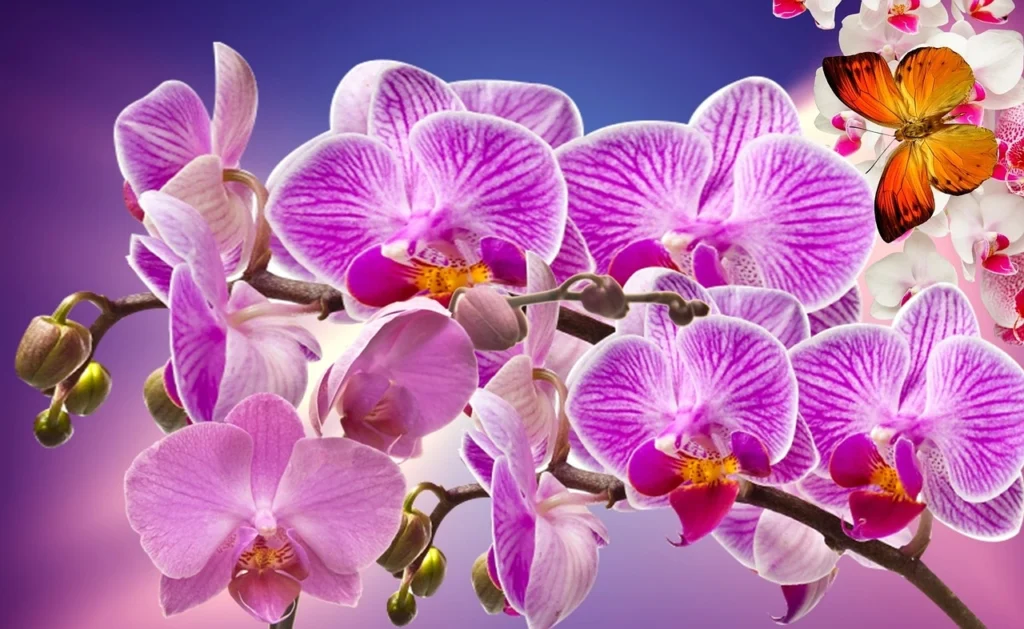Renowned for their captivating beauty and exotic charm, purple orchids are among the most stunning and striking plants in the world. Their vivid hues and graceful form make them a favored choice for enhancing home aesthetics, as well as gracing weddings and other grand occasions. However, mastering the art of cultivating and nurturing these magnificent plants can prove challenging without proper guidance. This post delves into everything you need to know about purple orchids, from their rich symbolism to essential care tips, ensuring your orchids flourish throughout the year.
The Symbolism of Purple Orchids
Purple orchids have been historically linked with opulence, aristocracy, and admiration. Their bold color has long represented nobility and affluence. Across various cultures, gifting a purple orchid symbolizes profound respect, admiration, and a sense of dignity. In the practice of Feng Shui, purple orchids are often regarded as tokens of prosperity and success, used to attract positive and flourishing energy.
Why Purple Orchids Hold Unique Allure?
Beyond their radiant appearance, purple orchids possess qualities that set them apart. Belonging to the Orchidaceae family, one of the largest in the plant kingdom, they hold a prominent place in the botanical world. Their allure, combined with the scarcity of many species in natural habitats, renders them highly desirable. Numerous varieties of orchids hail from tropical regions, and their exotic elegance imparts a distinct touch of sophistication wherever they reside.
Types of Purple Orchids for Home Cultivation
A variety of purple orchids can be nurtured at home, each offering its own unique charm. Some of the most popular types include:
- Phalaenopsis Orchids – Also known as moth orchids, they are perfect for beginners due to their easy care.
- Cattleya Orchids – Famous for their large, fragrant blooms, they often display a mix of purple hues.
- Dendrobium Orchids – With vibrant purple flowers, these orchids require a bit more care but reward with their stunning beauty.
- Vanda Orchids – Known for their rich purple tones and intricately patterned petals, they thrive in warm, humid conditions.
Each orchid variety has specific care needs, so it’s essential to understand the requirements of the one you choose.
Caring for Purple Orchids
Successfully cultivating purple orchids at home is immensely rewarding when proper care techniques are followed. Here’s an overview of the key factors:
Light Requirements
Orchids thrive under bright, diffused light. Too much direct sunlight can burn the leaves, while inadequate light may stunt growth. East-facing windows generally provide the perfect balance of light for most orchids.
Watering Schedule
Watering frequency depends on the species, but a general guideline is to water once a week, allowing the potting mix to dry out between sessions. Overwatering is a common problem and can cause root rot, so it’s important to avoid it.
Humidity Levels
Purple orchids flourish in environments with humidity levels of 50-70%. In dry climates, you can boost humidity by misting around the plants or placing them near a humidity tray.
Temperature Preferences
Orchids prefer temperatures ranging from 65-75°F (18-24°C) during the day and 55-65°F (13-18°C) at night. Avoid exposing orchids to drafts or heat sources that cause temperature changes, as this can stress the plants.
Fertilization Needs
To encourage healthy growth and blooming, use a balanced orchid fertilizer (20-20-20) every two weeks during the active growing season. Be cautious, as over-fertilizing can damage the roots.

Common Orchid Problems and Solutions
Like any plant, purple orchids can encounter challenges. Here are some common problems and their solutions:
Yellowing Leaves
Yellow leaves often indicate overwatering or insufficient light. Adjust your watering habits and ensure the orchid receives enough indirect light.
Lack of Blooms
If your orchid isn’t flowering, it could be due to inadequate lighting or unsuitable temperature conditions. Consider moving the plant to a brighter location and ensure the temperature is within the optimal range.
Root Rot
Root rot can result from overwatering or poor drainage. If you observe mushy, dark roots, reduce watering and repot the orchid in a well-draining medium.
Pests
Orchids can sometimes be vulnerable to pests like aphids, mealybugs, and spider mites. Address infestations by using organic insecticidal soap or wiping the leaves with a solution of water and rubbing alcohol.
Repotting Purple Orchids
Repotting is a critical aspect of maintaining the health of your orchids, as the potting medium deteriorates over time. Most orchids need repotting every 1-2 years. Here’s how to do it:
- Opt for a specialized orchid potting mix, as regular soil is too heavy for orchids.
- Gently take the orchid out of its current pot, shaking off the old medium.
- Carefully remove the orchid from its current pot, shaking off the old medium.
- Trim any dead or rotting roots.
- Place the orchid in a new pot and fill it with fresh potting mix, ensuring it is not packed too tightly.
Repotting refreshes the plant’s environment, providing the orchid with a renewed foundation to flourish.
Encouraging Purple Orchids to Bloom Again
Encouraging your purple orchids to bloom again can be a challenge, but with the right conditions, you can enjoy their beautiful flowers time and again. Follow these tips:
- Ensure proper lighting by providing bright, indirect sunlight.
- Once the orchid has finished blooming, provide it with a resting period involving cooler temperatures and less frequent watering.
- Use a fertilizer with higher phosphorus content (such as 10-30-20) during the blooming season to encourage flowering.
Are Purple Orchids Pet-Friendly?
A common concern for pet owners is whether purple orchids are safe for animals. Fortunately, orchids are non-toxic to both cats and dogs, so you can cultivate these beautiful plants without worry if your pets decide to nibble on them.
Final Thoughts
Purple orchids are a captivating enhancement to any space, bringing a touch of elegance and beauty. While they may require a bit more attention than other houseplants, their breathtaking beauty and rich symbolism make them worth the effort. By following the care tips outlined in this guide, your orchids will thrive, blooming year after year, whether you’re new to orchids or a seasoned enthusiast.




